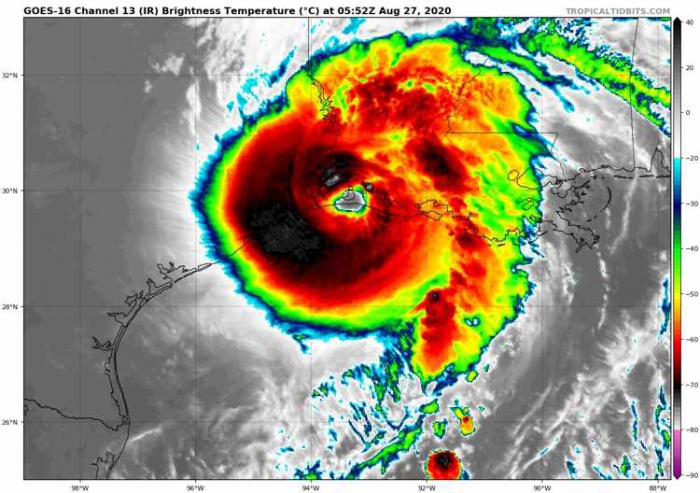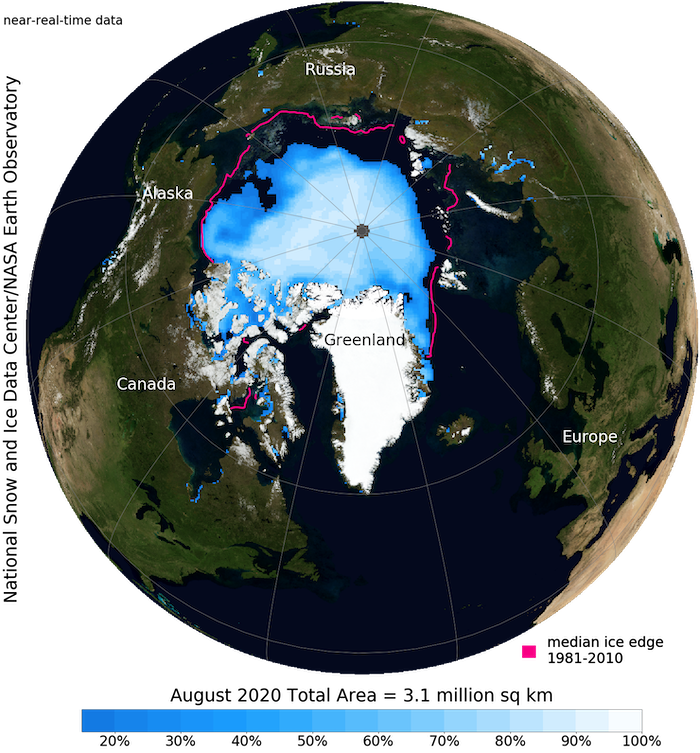By: François Massonnet, UCLouvain; Louis-Philippe Caron, Barcelona Supercomputing Center; Philip J. Klotzbach, Colorado State University; Tom J. Philp, London School of Economics; and Julienne Stroeve, National Snow and Ice Data Center and the University of Manitoba.
Accelerated Arctic sea ice melt and increased Atlantic hurricane activity are often quoted as tangible manifestations of ongoing climate change. September 2020 is the second time since 1979 that the pan-Arctic sea-ice extent has dropped below 4 million square kilometers. Meanwhile, an unprecedented number of seven named storms already made landfall in the continental U.S. by the end of August. Even though the processes underlying sea ice and hurricane dynamics are different, the desire to improve forecasting capabilities at seasonal time scales has been a primary concern in the respective scientific communities.

Editor's note: NOAA satellite data are available via Tropical Tidbits.

After the dramatic and unexpected retreat of Arctic sea ice in September 2007 (26% below the previous year), the polar scientific community started to structure itself around a project organized through the Study of Environmental Arctic Change (SEARCH) called the Sea Ice Outlook (SIO). Since 2014, the SIO is run under the umbrella of the U.S. agency-funded Sea Ice prediction Network. Each year, the SIO collects and synthesizes outlooks of pan-Arctic and regional sea ice conditions for the month of September, producing real-time information on the likely development of sea ice throughout the melting season. A similar platform for hurricane forecasting (Seasonal Hurricane Predictions) has been set up since 2016, spearheaded by the Barcelona Supercomputing Center and Colorado State University and supported by XL Catlin (now (AXA XL)). Like the SIO, this effort relies on volunteer participation of the forecasters and welcomes any forecast made by meteorologists or climatologists, from statistical to dynamical ones.
In both cases, the skill of seasonal forecasts remains moderate. The SIO forecasts hardly beat persistence and trend extrapolation forecasts and large deviations from the long-term trend line, like the 2012 record minimum, are not captured by the ensemble median forecast. For Atlantic hurricanes, the forecasts under-predicted the hyperactive 2017 season (median forecast of seven hurricanes, 10 eventually observed), although groups were more successful in predicting the very active 2020 hurricane season currently underway. More years will be needed to robustly establish the skill of the ensemble and whether these forecasts are superior to elementary benchmark forecasts.
The sea-ice and hurricane forecasting communities face similar challenges. For example, the variables typically forecasted in each case (pan-Arctic sea ice extent, hurricane count) are hardly relevant for stakeholders who need more targeted regional information, like the date of sea-ice retreat and the expected number of hurricane landfalls on specific segments of the continental U.S. coastline. Another challenge is the fact that the underlying physical processes driving sea-ice evolution and hurricane formation are likely not stationary, meaning that predictor-predictand relationships might change due to both natural climate variability and anthropogenic climate change. These challenges are actively addressed in the respective activities.
Sustained efforts in the coordination of international seasonal prediction efforts like the SIO and the seasonal hurricane prediction platform will be key to move forecasts beyond the academic framework and reveal their full potential in the context of climate services, like weather forecasting did at the end of the twentieth century. Fueled by advances in fundamental research on climate predictability and by continued dialogue between the scientific community and stakeholders, expectations can legitimately be high for the years to come.
Reference
Caron, Louis-Philippe, François Massonnet, Philip J. Klotzbach, Tom J. Philp, and Julienne Stroeve (2020). "Making Seasonal Outlooks of Arctic Sea Ice and Atlantic Hurricanes Valuable—Not Just Skillful." Bulletin of the American Meteorological Society 101,1: E36–42. https://doi.org/10.1175/BAMS-D-18-0314.1.
About the Authors
 François Massonnet is a Research Associate at UCLouvain. His research interests include climate prediction and variability, polar regions, sea ice, data assimilation, climate model evaluation, and forecast verification. His work is focused on the use and assessment of climate general circulation models for prediction at time scales from the month to the decade.
François Massonnet is a Research Associate at UCLouvain. His research interests include climate prediction and variability, polar regions, sea ice, data assimilation, climate model evaluation, and forecast verification. His work is focused on the use and assessment of climate general circulation models for prediction at time scales from the month to the decade.
 Louis-Philippe Caron is a Research Scientist in the Earth Sciences – Climate Prediction Group at the Barcelona Supercomputing Center. His research activities focus on sea-ice variability, prediction, and impacts; ocean biogeochemistry and climate feedbacks; tropical cyclones; Atlantic variability and predictability, climate model initialization and data assimilation; insurance services; and forecast quality assessment of seasonal-to-decadal predictions.
Louis-Philippe Caron is a Research Scientist in the Earth Sciences – Climate Prediction Group at the Barcelona Supercomputing Center. His research activities focus on sea-ice variability, prediction, and impacts; ocean biogeochemistry and climate feedbacks; tropical cyclones; Atlantic variability and predictability, climate model initialization and data assimilation; insurance services; and forecast quality assessment of seasonal-to-decadal predictions.
 Philip J. Klotzbach is a Research Scientist in the Department of Atmospheric Science at Colorado State University. He became first author on the seasonal hurricane forecasts in 2006. Klotzbach developed the two-week forecasts currently being issued during the peak months of the hurricane season between August-October.
Philip J. Klotzbach is a Research Scientist in the Department of Atmospheric Science at Colorado State University. He became first author on the seasonal hurricane forecasts in 2006. Klotzbach developed the two-week forecasts currently being issued during the peak months of the hurricane season between August-October.
Tom J. Philp is with the London School of Economics in London, United Kingdom.
 Julienne Stroeve is a Senior Research Scientist at the National Snow and Ice Data Center and a professor at the Centre for Earth Observation Science in the Department of Environment and Geography at the University of Manitoba. She specializes in remote sensing of snow and ice in the visible, infrared, and microwave wavelengths.
Julienne Stroeve is a Senior Research Scientist at the National Snow and Ice Data Center and a professor at the Centre for Earth Observation Science in the Department of Environment and Geography at the University of Manitoba. She specializes in remote sensing of snow and ice in the visible, infrared, and microwave wavelengths.
